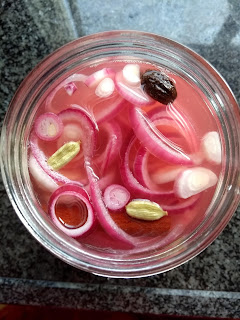My new addiction. These onion pickles have an almost perfumed quality that I wasn't sure I liked at first, but they have become a daily habit--on sandwiches, on poké bowls, on salads, as a side with curries. They come from a recently released Dutch cookbook written by an Indian expat.
The book (De Bible van de Indiase Keuken by Paulami Joshi) covers many familiar recipes, certainly for someone like me who has got a fair collection of Indian cookbooks. The recipes are grouped by region and they include some unfamiliar dishes. The book has good illustrated how-to sections on making breads and some other things. It's one weakness is the index, which is almost useless unless you know the exact recipe name. Look under a recipe's major ingredient, like cauliflower or, in this case, onions, and you won't find the recipe listing.
But the recipes are great and this one is a real gem.
Ingredients
240 ml (1 cup) vinegar
120 ml (1/2 cup) water
3 cloves
1 black cardamom pod, bruised
3 green cardamom pods, bruised
1 cinnamon stick
200-250 g (7-8 oz) red onions or shallots, thinly sliced
1 teaspoon sugar
2 teaspoons salt
Directions
Have ready a sterilized 400 ml jar with a screw-on lid.
- In a small saucepan, bring the vinegar, water, and spices to a boil, then simmer for 5 minutes.
- While that simmers, thinly slice the onions and put them in the sterilized jar.
- Pour the spiced liquid and spices over the onions, screw on the lid and let cool. once it has cooled, keep it in the fridge for up to 2 months. (My first batch only lasted for 3 weeks.)
Source: De Bible van de Indiase Keuken By Paulami Joshi




















